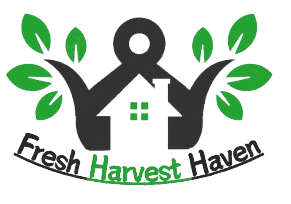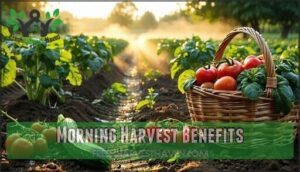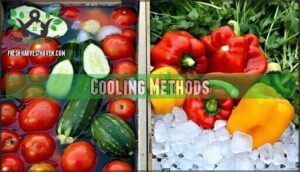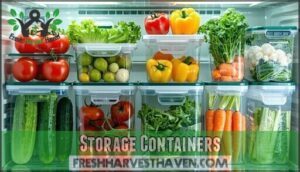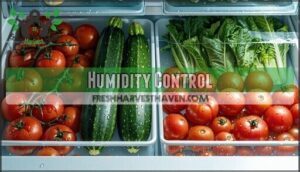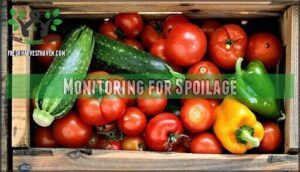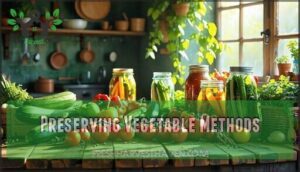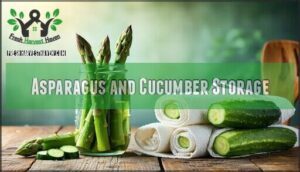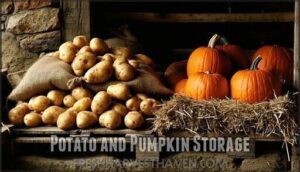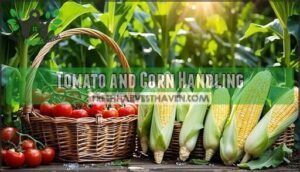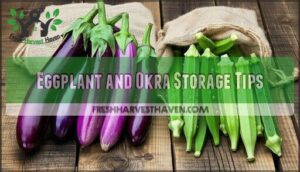This site is supported by our readers. We may earn a commission, at no cost to you, if you purchase through links.

Pick vegetables early morning when they’re hydrated and cool – tomatoes when fully colored, cucumbers when firm and bright green, and beans when pods snap crisply.
Use sharp tools to avoid plant damage and harvest regularly to encourage continued production.
Immediately cool harvested vegetables in cold water or refrigerate to maintain quality.
For long-term storage, blanch vegetables before freezing, use proper canning techniques, or try dehydration methods.
Each vegetable has specific preservation requirements that can extend your harvest for months.
Table Of Contents
- Key Takeaways
- Harvesting Summer Vegetables
- Morning Harvest Benefits
- Storing Harvested Vegetables
- Preserving Vegetable Methods
- Specific Vegetable Care
- Frequently Asked Questions (FAQs)
- How to preserve summer vegetables?
- What do you harvest in summer?
- How to store vegetables from a garden long term?
- How to store vegetables in summer?
- How do you preserve summer vegetables?
- How do you preserve summer harvest?
- When to harvest summer vegetables?
- How do you keep vegetables fresh after harvesting?
- How to preserve summer harvest?
- How to store summer vegetables?
- Conclusion
Key Takeaways
- Harvest at peak ripeness during morning hours – You’ll get maximum flavor and freshness when vegetables are cool and fully hydrated from overnight moisture
- Use proper harvesting techniques with sharp tools – You’ll prevent plant damage and maintain quality by cutting cleanly and handling gently during collection
- Cool vegetables immediately after harvest – You’ll extend shelf life significantly by removing field heat through cold water baths or refrigeration within the first hour
- Choose the right preservation method for each vegetable – You’ll maximize storage life by blanching before freezing, following tested canning recipes, or using dehydration and pickling techniques based on your vegetable type
Harvesting Summer Vegetables
You’ll know your summer vegetables are ready when they show clear signs of ripeness, like firm texture and vibrant color changes.
Regular harvesting every few days keeps plants producing more food and prevents vegetables from becoming tough or overripe.
Checking for Readiness
Determining readiness starts with knowing when your vegetables have reached peak maturity and quality.
Check these essential Visual Cues and Ripeness Indicators:
- Maturity Dates – Reference seed packets for estimated harvest windows
- Texture Assessment – Gently squeeze to test firmness and ripeness
- Optimal Size – Look for variety-specific size recommendations
- Vegetable Ripeness Signs – Watch for color changes and surface smoothness
These Harvesting Techniques help you identify the Optimal Harvest Time for maximum flavor.
Harvesting Techniques
With proper harvesting techniques, you’ll maximize your summer vegetable yields while keeping plants healthy.
Sharp knives work best for leafy greens, ensuring clean cuts that prevent disease. Garden forks gently loosen root crops without bruising.
Pruners handle vine fruits with precise 45-degree cuts. Hand tools twist tender pods firmly but carefully. Scissors snip herbs cleanly.
Ideal tooling and gentle handling minimize damage while avoiding bruising during harvest, which is crucial for maintaining healthy plants.
Peak Ripeness
Ripening summer vegetables give clear signals when they’re ready for harvest. Visual cues matter most—look for vibrant, consistent coloring that signals peak ripeness. Texture assessment through gentle pressure reveals ideal timing for many crops.
Here’s your harvest timing checklist:
- Visual Cues: Watch for color changes from green to red, yellow, or deep purple depending on variety
- Texture Assessment: Test firmness with gentle pressure—tomatoes yield slightly when ready
- Maturity Dates: Check seed packets for expected harvest windows and use as timing guides
- Flavor Indicators: Trust your nose—ripe vegetables often develop distinctive, sweet aromas
Perfect harvest timing maximizes both flavor development and nutritional content in your summer vegetables.
Regular Harvesting for Continuous Production
Regular harvesting maximizes yield and keeps summer vegetables producing longer.
Pick beans every 2-3 days to boost production by 40%, and harvest tomatoes daily once they start ripening.
This regular harvesting schedule prevents plants from shifting energy to seed production, maintaining plant health and encouraging continuous flowering.
Consistent harvest timing also improves quality maintenance by preventing overripe vegetables that attract pests.
Well-timed resource allocation through frequent picking extends your growing season substantially.
To guarantee the best flavor, consider morning harvest benefits.
Morning Harvest Benefits
You’ll discover that morning harvests deliver superior flavor and freshness thanks to cooler temperatures and better plant hydration from overnight moisture.
This timing also reduces heat stress on both you and your vegetables, preventing wilting and maintaining peak quality from garden to storage, which is crucial for preserving the flavor.
Cooler Temperatures
Morning harvests tap into nature’s cooler temperatures, giving your vegetables their best shot at lasting longer.
When you harvest before the sun heats up, you’re working with Ideal Temperatures that slow down spoilage and maintain quality.
Here’s why Temperature Impact matters for your summer harvest:
- Lower respiration rates preserve nutrients and flavor
- Reduced wilting keeps vegetables crisp longer
- Less heat stress prevents cellular damage
- Extended shelf life through natural Cold Storage conditions
Smart vegetable harvesting means timing beats everything else for preserving vegetables.
Better Hydration
During morning harvests, your summer vegetables reach peak turgor pressure and cellular hydration levels.
This natural timing optimizes nutrient transport and minimizes post-harvest wilting.
Plants maintain maximum water content from overnight recovery, enhancing vegetable preservation quality.
One should also consider that regular harvesting boosts plant health and herb quality.
Better hydration directly impacts texture and flavor retention, making your summer harvest ideal for both immediate use and preserving vegetables through various methods.
Reduced Damage
Cool morning air keeps vegetables firm and less prone to damage.
Gentle handling and sharp tools prevent bruising during vegetable harvesting.
Use proper containers with minimal contact for careful transport.
This approach guarantees bruising prevention and cracking prevention, keeping your summer harvest looking perfect.
Storing Harvested Vegetables
Once you’ve harvested your summer vegetables, proper storage becomes your next priority to maintain freshness and prevent waste.
The way you handle and store your produce immediately after picking can make the difference between vegetables that last days versus weeks.
Cooling Methods
Speed matters when you’ve just harvested summer vegetables.
Every hour after harvest costs you flavor and freshness.
Quick cooling prevents quality loss and extends shelf life substantially.
Choose the right method for your situation:
- Hydro-cooling – submerge vegetables in ice water for rapid temperature drop
- Vacuum cooling – removes heat through moisture evaporation under pressure
- Icing techniques – pack produce with crushed ice for gradual cooling
- Forced-air cooling – circulates cold air, cooling 10 times faster than room temperature.
To maintain freshness, consider optimal humidity control after cooling.
Storage Containers
Selecting the right storage containers makes all the difference in preserving your summer harvest.
Airtight containers work best for leafy greens, while breathable materials like mesh bags suit root vegetables perfectly.
Perforated bags create ideal container ventilation in your refrigerator.
For maximum preservation, consider the benefits of proper food sealing.
Choose stackable designs to maximize space in basements or pantries.
Match container sizes to your typical harvest amounts, and invest in quality vegetable storage solutions that’ll last season after season.
Humidity Control
Mastering humidity control means the difference between crisp vegetables and mushy disappointments in your storage. Proper humidity management creates ideal levels that preserve freshness while preventing spoilage. Most vegetables thrive at 85-95% humidity, striking the perfect balance for storage methods.
Perfect humidity control turns summer vegetables into winter treasures that taste just-picked fresh.
Here’s your humidity control playbook:
- Set crisper drawers to high humidity for leafy greens and vegetables needing moisture retention
- Use breathable containers with air circulation to prevent condensation risks and maintain container breathability
- Monitor moisture buildup regularly, adjusting ventilation to avoid excess humidity that leads to decay
Effective vegetable storage humidity control prevents mold prevention issues while maintaining produce quality. Condensation prevention requires proper air circulation through perforated bags or ventilated containers. This approach extends shelf life substantially compared to sealed storage that traps moisture and accelerates spoilage.
Monitoring for Spoilage
Why ignore the warning signs when early detection saves your harvest? Check stored vegetables daily for spoilage signs: soft spots, mold growth, and color alterations.
Texture changes and odor indicators reveal problems before they spread. Proper monitoring spoilage guarantees food safety and prevents contamination throughout your vegetable storage system.
| Warning Sign | What to Look For | Action Needed |
|---|---|---|
| Mold Growth | Fuzzy patches, discoloration | Remove immediately |
| Texture Changes | Soft spots, wrinkled skin | Use quickly or discard |
| Odor Indicators | Off smells, fermentation | Check surrounding produce |
Daily inspections prevent small problems from becoming storage disasters, protecting your entire harvest investment.
Preserving Vegetable Methods
Once you’ve successfully harvested your summer bounty, you’ll want to preserve that peak flavor and nutrition for months ahead.
The right preservation method can transform your garden’s overflow into pantry staples that’ll keep you eating well all winter long, utilizing the best of your summer bounty.
Blanching Techniques
Proper blanching is your secret weapon for vegetable preservation success. This quick pre-treatment involves immersing vegetables in boiling water, then immediately cooling them in ice water to halt the cooking process.
Key blanching benefits include:
- Enzyme inactivation that prevents spoilage
- Color retention for vibrant appearance
- Nutrient preservation up to 80% after storage
- Texture impacts that maintain crispness
Different blanching methods work for various vegetables. Steam blanching suits dense items like carrots, while boiling water works best for leafy greens. Time matters – green beans need exactly three minutes, while spinach requires just two. Under-blanching fails to deactivate enzymes, leading to freezer burn.
Freezing and Canning
After proper blanching benefits your vegetables, freezing and canning become your preservation powerhouses. These food preservation methods lock in peak flavors and nutrients when done correctly.
- Freezing vegetables requires blanching first, then rapid cooling and airtight packaging at 0°F
- Canning vegetables demands sterilized jars and tested recipes for safe storage
- Canning acidity levels must meet safety standards—add lemon juice to tomatoes
- Recipe testing confirms proper processing times and temperatures for different vegetables
- Safe storage means monitoring freezing textures and checking sealed jars regularly. To guarantee proper freezing, you’ll need to source suitable freezer supplies.
Pickling and Dehydrating
Pickling vegetables like cucumbers, carrots, and green beans transforms your harvest into tangy treasures.
Vinegar brines with at least 2% salt create the perfect acidic environment, while pickling spices add complex flavors.
For drying vegetables, choose between electric dehydrator types or your oven set low.
Drying herbs works beautifully at 135°F for 8-12 hours.
Both preserving techniques offer excellent food preservation options.
Dehydrating removes moisture below 10% to prevent spoilage, while proper safe canning methods guarantee your pickled creations last up to 12 months when stored correctly.
Vacuum Sealing
Vacuum sealing transforms your food preservation techniques by removing air that causes spoilage. Choose heavy-duty bags designed for your vacuum sealer types to prevent tears during processing. This method excels at preventing freezer-burn while extending shelf life substantially.
For maximum preservation, consider the different bag options available.
- Extending shelf-life by removing oxygen that breaks down nutrients
- Food safety through reduced bacterial growth in sealed environments
- Bag selection matters – use textured bags for better air removal
- Best vegetables for vacuum sealing include blanched corn, green beans, and peppers
- Perfect pairing with freezing for maximum preservation results
Specific Vegetable Care
Each summer vegetable has unique storage requirements that can make or break your harvest’s longevity.
Understanding these specific needs helps you maximize freshness and prevent waste while enjoying your garden’s bounty for months to come, which is crucial for maintaining the longevity of your harvest.
Asparagus and Cucumber Storage
When storing asparagus upright in a jar with water, you’ll extend freshness up to seven days.
Keep cucumbers cool at 50-55°F, wrapped in dry paper towels to control cucumber humidity and prevent spoilage.
| Storage Method | Shelf Life |
|---|---|
| Asparagus upright | 2 weeks |
| Cucumber wrapped | 1 week |
These storage duration techniques guarantee flavor retention and spoilage prevention for maximum freshness.
Potato and Pumpkin Storage
Root vegetables need special care for maximum shelf life.
Store potatoes at 45-50°F with 90% humidity in breathable containers, avoiding light exposure which increases harmful solanine levels.
For pumpkins, maintain 50-59°F temperatures in ventilated spaces to prevent mold.
- Keep potatoes cool and dark to prevent sprouting and solanine buildup
- Cure pumpkins in sunlight before moving to storage areas
- Use ventilated containers to maintain proper airflow and humidity
Tomato and Corn Handling
Handle tomatoes at the tomato breaker stage when half-pink for ideal ripeness.
Sweet corn reaches peak sweet corn flavor when silks show silk browning signs and kernel plumpness appears.
Direct sunlight impact reduces corn sweetness, so chill corn within one hour after harvest.
Store tomatoes stem-down at room temperature, avoiding refrigeration to preserve flavor and texture.
Eggplant and Okra Storage Tips
Eggplants and okra require different storage approaches to maintain quality.
Eggplant bruising occurs easily, so handle gently and store at 50°F to prevent chilling injury.
Okra sliminess develops quickly at room temperature, making refrigeration essential for extending shelf life.
Proper airflow can also help, as perforated bags usage is recommended for ideal storage.
Smart storage strategies:
- Keep eggplants at 50°F – temperatures below 45°F cause chilling damage and brown spots
- Store okra in perforated bags – reduces decay by 40% compared to room temperature storage
- Maintain proper humidity levels – 90-95% for okra, moderate for eggplants to prevent moisture loss
- Monitor temperature sensitivity – both vegetables deteriorate rapidly outside preferred ranges
These summer vegetables reward careful attention to storage conditions with extended freshness.
Frequently Asked Questions (FAQs)
How to preserve summer vegetables?
You’ll want to freeze, can, or dry your summer bounty to enjoy year-round. Blanch vegetables before freezing, follow tested canning recipes for safety, and dehydrate for shelf-stable snacks.
What do you harvest in summer?
You’ll harvest tomatoes, zucchini, cucumbers, green beans, peppers, and sweet corn during summer months. Pick these vegetables when they’re firm, properly colored, and at peak ripeness for best flavor.
How to store vegetables from a garden long term?
Store your garden vegetables long-term by controlling temperature and humidity.
Use cold, dry storage for pumpkins and winter squash.
Keep root vegetables in cold, moist conditions.
Freeze, can, or dehydrate excess produce for year-round enjoyment.
How to store vegetables in summer?
Beat the heat like a pro by moving harvested vegetables to shade immediately, then chill them quickly to remove field heat.
Store most in cold, moist conditions at 32-40°F with high humidity, using perforated bags for proper ventilation to maintain the right environment.
How do you preserve summer vegetables?
You can preserve summer’s bounty through freezing, canning, drying, or pickling.
Blanch vegetables before freezing, follow tested recipes for canning, dehydrate for chips, or pickle in vinegar brines for extended freshness.
How do you preserve summer harvest?
Safeguarding your garden’s bounty doesn’t require fancy equipment—you’ll master blanching vegetables before freezing.
Canning acidic tomatoes safely, pickling crisp cucumbers in vinegar brines, or dehydrating peppers into flavorful chips for year-round enjoyment.
When to harvest summer vegetables?
Harvest tomatoes when fully colored and slightly soft, zucchini at 6-8 inches long, and cucumbers when firm with consistent color. Check daily during peak season for ideal ripeness and flavor.
How do you keep vegetables fresh after harvesting?
Move harvested vegetables to shade immediately, then gently brush off soil without washing.
Pre-cool produce to remove field heat, store in breathable containers with proper humidity, and refrigerate most crops promptly, following complete concepts for handling.
How to preserve summer harvest?
Like a treasure chest locks away precious jewels, you’ll want to freeze, can, pickle, or dry your summer bounty.
Blanch vegetables before freezing, follow tested recipes for canning, and store everything properly labeled with dates for safe, delicious meals year-round, using methods like pickle to preserve your food.
How to store summer vegetables?
Store summer vegetables by controlling temperature and humidity.
Keep tomatoes at room temperature, refrigerate leafy greens in perforated bags, and store root vegetables in cool, moist conditions.
Harvest regularly and handle gently to maximize freshness.
Conclusion
Like a well-tended garden that rewards patience with abundance, mastering harvesting and preserving summer vegetables transforms your seasonal bounty into year-round nourishment.
You’ve learned the essential techniques for timing your harvest, maintaining freshness, and extending shelf life through proven preservation methods.
Whether you’re blanching beans for the freezer or perfecting your canning skills, these strategies guarantee none of your hard work goes to waste.
Start small, practice consistently, and you’ll soon develop the confidence to preserve your entire summer harvest successfully.
- https://culturesforhealth.com/blogs/learn/how-to-store-and-preserve-garden-vegetables
- https://ponicslife.com/storing-and-preserving-vegetables-a-complete-guide/
- https://www.canr.msu.edu/news/refrigerator_humidity_effects_on_produce_quality
- https://extension.umaine.edu/publications/4135e/
- https://forksinthedirt.com/preserve-your-harvest/
